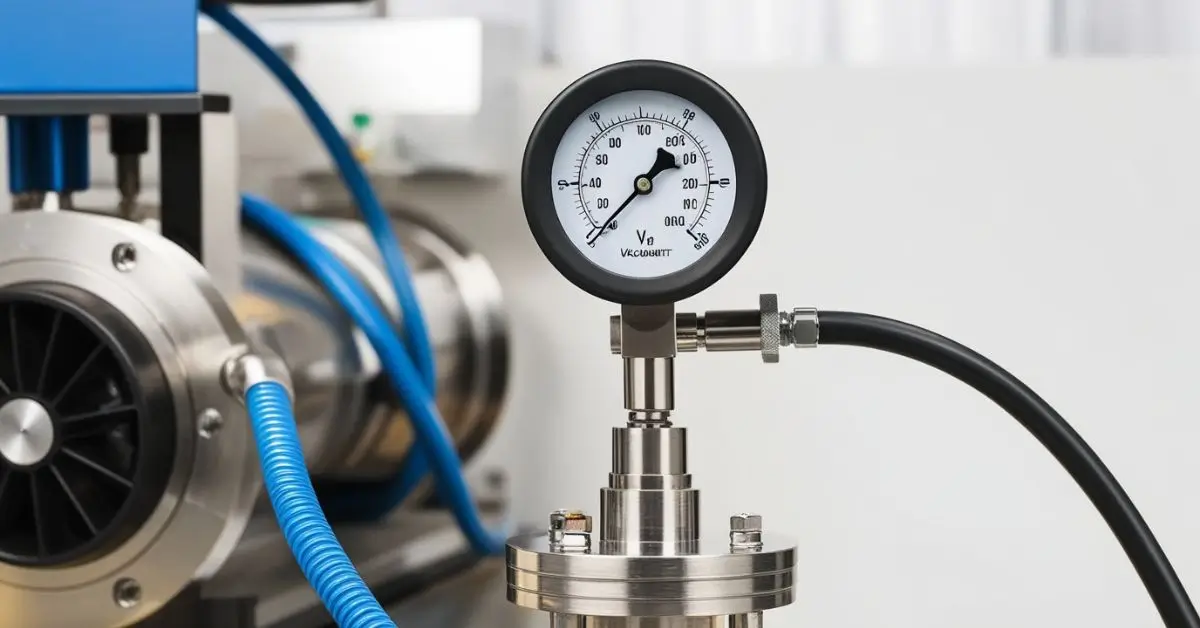A vacuometer, also known as a vacuum gauge, is an essential tool used to measure the pressure of a vacuum in various settings, from industrial machinery to laboratory environments. The ability to measure and monitor vacuum levels accurately is critical for several sectors, including manufacturing, automotive, medical, and scientific research.
The application of vacuometers is widespread due to their ability to monitor both very low and very high vacuums. They play a crucial role in ensuring that systems reliant on vacuum technologies, such as refrigeration, automotive engines, and high-tech manufacturing equipment, operate at optimal levels. This article will provide an in-depth exploration of vacuometers, discussing their types, principles of operation, applications, and importance in various industries.
What Is a Vacuometer?
A vacuometer is a device used to measure the pressure in a vacuum, typically expressed in units such as torr, pascal (Pa), or millibar (mbar). Vacuometers gauge the absence of atmospheric pressure in a system, which is essential for processes that depend on maintaining specific vacuum conditions.
Vacuometers can measure pressures lower than atmospheric pressure, which is why they are used to gauge vacuums. Depending on the application, vacuometers can be designed for different sensitivity levels and accuracy, from measuring slight reductions in pressure to reading ultra-high vacuums required in scientific experiments.
History of Vacuometers
The development of vacuometers is closely tied to the evolution of vacuum technology. The use of vacuums in scientific experiments began in the 17th century when scientists such as Evangelista Torricelli and Otto von Guericke made pioneering discoveries related to atmospheric pressure and vacuums. Torricelli’s invention of the barometer to measure atmospheric pressure in 1643 laid the foundation for the development of vacuometers.
As technological advancements increased the demand for vacuum-related processes, so did the need for more sophisticated and precise vacuum measurement tools. The modern vacuometer has evolved into a highly specialized instrument that can accurately monitor vacuum levels across various industries.
How Vacuometers Work
Vacuometers work by measuring the pressure difference between a vacuum system and atmospheric pressure. The principles behind vacuum measurement depend on the type of vacuometer being used. In general, vacuometers can be categorized into two main types based on the pressure range they measure:
- Mechanical Vacuometers (Low to Medium Vacuum Measurement)
- Electrical Vacuometers (High to Ultra-High Vacuum Measurement)
Mechanical Vacuometers
Mechanical vacuometers are typically used for measuring low and medium vacuums. These devices rely on the deformation of mechanical components to indicate pressure levels. Some of the common types of mechanical vacuometers include:
- Bourdon Tube Gauge: This is one of the simplest and most widely used vacuometers for low and medium vacuums. It consists of a curved tube that deforms when exposed to pressure. As the pressure decreases inside the vacuum system, the tube straightens out, and this movement is converted into a pressure reading.
- Diaphragm Gauge: The diaphragm gauge works by measuring the deflection of a flexible membrane or diaphragm. As the vacuum increases, the diaphragm deflects, and this deflection is used to indicate the pressure level.
- McLeod Gauge: The McLeod gauge is a mechanical vacuometer that is used to measure very low pressures by compressing a known volume of gas. By measuring the change in volume, the pressure can be calculated. This gauge is used primarily in laboratory settings for high-accuracy measurements of low vacuums.
Electrical Vacuometers
Electrical vacuometers are used for measuring high to ultra-high vacuums and rely on electrical properties, such as ionization, to measure pressure. Common types include:
- Thermocouple Gauge: This type of vacuometer uses the principle of heat conduction to measure vacuum pressure. A thermocouple is heated, and the heat loss from the thermocouple is measured. In a vacuum, heat conduction is reduced, so the amount of heat lost provides an indication of the vacuum pressure.
- Ionization Gauge: Ionization gauges are used to measure very high vacuums. These gauges work by ionizing gas molecules in the vacuum and measuring the resulting ion current. The ion current is proportional to the vacuum pressure, so by measuring the current, the pressure can be determined.
- Capacitance Manometer: Capacitance manometers are used for high-precision measurements in high vacuum conditions. These gauges measure changes in capacitance as a diaphragm deforms under pressure. The small deformations are converted into electrical signals, which indicate the vacuum level.
Types of Vacuometers
The selection of a vacuometer depends on the specific vacuum range and application. The following are common types of vacuometers used in different industries:
- Bourdon Tube Vacuometer: Simple, durable, and inexpensive, this type is suited for low to medium vacuums, typically used in HVAC systems and industrial machinery.
- Thermocouple Gauge: Ideal for high vacuums, this gauge is widely used in vacuum furnaces, sputtering systems, and freeze-drying equipment.
- Capacitance Manometer: This precision gauge is used in semiconductor manufacturing, thin-film deposition, and other applications requiring high accuracy in high vacuums.
- Ionization Gauge: Suitable for ultra-high vacuum environments such as particle accelerators, space simulation chambers, and research laboratories.
- McLeod Gauge: Although less common today, McLeod gauges are still used in some laboratory settings where high-precision, low-pressure measurements are required.
Applications of Vacuometers
Vacuometers are essential in numerous industries due to their ability to monitor and control vacuum conditions. Here are some prominent sectors where vacuometers play a vital role:
Automotive Industry
In the automotive sector, vacuometers are used to test and tune engines. Many modern internal combustion engines rely on a vacuum system for optimal performance, and vacuometers help mechanics assess whether the system is functioning correctly. They are commonly used to check engine manifold vacuum, which is critical for diagnosing issues such as leaks, poor performance, or fuel efficiency problems.
Manufacturing
Vacuum technology is crucial in many manufacturing processes. For instance, vacuum chambers are used in the production of semiconductors, the packaging of food products, and the manufacturing of pharmaceuticals. Accurate vacuum measurement is vital to ensure product quality and prevent contamination.
In metalworking, vacuometers are used to monitor vacuum furnaces, which are essential for heat-treating processes such as annealing, brazing, and sintering. Maintaining the correct vacuum levels ensures the quality and mechanical properties of the treated materials.
Scientific Research
Research laboratories frequently use vacuometers to conduct experiments in vacuum environments. From space simulation chambers to particle accelerators, precise control and measurement of vacuum levels are critical. High-performance vacuometers, such as ionization gauges and capacitance manometers, are typically used in such applications.
HVAC Systems
In heating, ventilation, and air conditioning (HVAC) systems, vacuometers are used to measure the vacuum pressure during system maintenance and troubleshooting. Maintaining appropriate vacuum levels ensures the system runs efficiently and can help identify issues like leaks or blockages in the system.
Medical Field
In medical devices such as vacuum-assisted wound closure systems or laboratory equipment like centrifuges, vacuometers are used to maintain and monitor vacuum conditions. This is particularly important for sensitive medical processes where maintaining sterile conditions or precise atmospheric control is necessary.
Aerospace
The aerospace industry uses vacuometers in space simulation chambers, where spacecraft components are tested under vacuum conditions to simulate the environment of outer space. These vacuometers must be extremely precise, as even small pressure changes can have significant impacts in space conditions.
The Importance of Vacuometers in Modern Technology
The accurate measurement and control of vacuum levels are critical in numerous fields of modern technology. As processes become more advanced and require precise environmental conditions, the role of vacuometers becomes even more indispensable. They ensure that systems operate within the necessary vacuum ranges, helping to prevent failures, optimize performance, and ensure the quality and safety of products and experiments.
In the semiconductor industry, for example, vacuometers are used to maintain vacuums in cleanrooms where microchips are manufactured. Even small amounts of contamination from the atmosphere can ruin entire batches of microchips, making vacuometer accuracy vital to the manufacturing process.
Similarly, in the automotive industry, vacuometers allow for precise monitoring of vacuum systems, which are integral to the engine’s performance. Without these gauges, diagnosing engine problems and ensuring optimal fuel efficiency would be significantly more challenging.
Challenges and Future Developments
While vacuometers are already highly advanced, there are several challenges and opportunities for future development. One ongoing challenge is improving the precision of vacuum measurement in ultra-high vacuum (UHV) environments. These environments, such as those found in particle accelerators or space simulation chambers, require vacuometers with extreme sensitivity.
Additionally, as industries move toward automation, there is an increasing demand for smart vacuometers that can integrate with automated systems, provide real-time data analysis, and offer remote monitoring capabilities. The development of wireless vacuometers and those with advanced sensor technologies may play a crucial role in the future of vacuum measurement.
Conclusion
Vacuometers are indispensable tools across various industries, from automotive diagnostics to semiconductor manufacturing. Their ability to measure and control vacuum levels ensures that critical processes function optimally. The wide range of vacuometer types—mechanical, electrical, and digital—offers flexibility to meet the specific needs of different applications, from low vacuum pressures in HVAC systems to ultra-high vacuums in scientific research.
As technology advances, so too will the precision and functionality of vacuometers. With increasing demands for higher accuracy, automation, and integration into complex systems, the role of vacuometers will continue to expand, shaping the future of industries that rely on vacuum technology.











